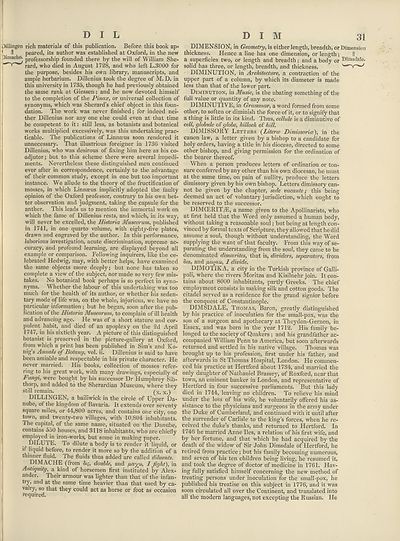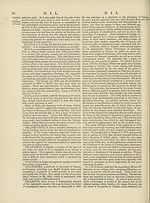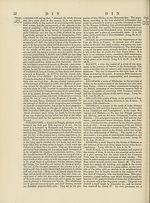Encyclopaedia Britannica > Volume 8, DIA-England
(41) Page 31
Download files
Complete book:
Individual page:
Thumbnail gallery: Grid view | List view

D I L DIM 31
Jillingen rich materials of this publication. Before this book ap-
’ . II peared, its author was established at Oxford, in the new
timache. professorship founded there by the will of William She-
rard, who died in August 1728, and who left L.3000 for
the purpose, besides his own library, manuscripts, and
ample herbarium. Dillenius took the degree of M. D. in
this university in 1735, though he had previously obtained
the same rank at Giessen; and he now devoted himself
to the completion of the Pinax, or universal collection of
synonyms, which was Sherard’s chief object in this foun¬
dation. The work was never finished; for indeed nei¬
ther Dillenius nor any one else could even at that time
be competent to it: still less, as botanists and botanical
works multiplied excessively, was this undertaking prac¬
ticable. The publications of Linnaeus soon rendered it
unnecessary. That illustrious foreigner in 1736 visited
Dillenius, who was desirous of fixing him here as his co¬
adjutor; but to this scheme there were several impedi¬
ments. Nevertheless these distinguished men continued
ever after in correspondence, certainly to the advantage
of their common study, except in one but too important
instance. We allude to the theory of the fructification of
mosses, in which Linnaeus implicitly adopted the faulty
opinion of the Oxford professor, contrary to his own bet¬
ter observation and judgment, taking the capsule for the
anther. This leads us to mention the immortal work on
which the fame of Dillenius rests, and which, in its way,
will never be excelled, the Historia Muscorum, published
in 1741, in one quarto volume, with eighty-five plates,
drawn and engraved by the author. In this performance,
laborious investigation, acute discrimination, supreme ac¬
curacy, and profound learning, are displayed beyond all
example or comparison. Following inquirers, like the ce¬
lebrated Hedwig, may, with better helps, have examined
the same objects more deeply; but none has taken so
complete a view of the subject, nor made so very few mis¬
takes. No botanical book perhaps is so perfect in syno¬
nyms. Whether the labour of this undertaking was too
much for the health of its author, or whether his seden¬
tary mode of life was, on the whole, injurious, we have no
particular information; but he began, soon after the pub¬
lication of the Historia Muscorum, to complain of ill health
and advancing age. He was of a short stature and cor¬
pulent habit, and died of an apoplexy on the 2d April
1747, in his sixtieth year. A picture of this distinguished
botanist is preserved in the picture-gallery at Oxford,
from which a print has been published in Sim’s and Ko-
nig’s Annals of Botany, vol. ii. Dillenius is said to have
been amiable and respectable in his private character. He
never married. His books, collection of mosses refer¬
ring to his great work, with many drawings, especially of
Fungi, were bought by his successor Dr Humphrey Sib-
thorp, and added to the Sherardian Museum, where they
still remain. x>)
DILLINGEN, a bailiwick in the circle of Upper Da¬
nube, of the kingdom of Bavaria. It extends over seventy
square miles, or 44,800 acres, and contains one city, one
town, and twenty-two villages, with 10,804 inhabitants.
The capital, of the same name, situated on the Danube,
contains 550 houses, and 3118 inhabitants, who are chiefly
employed in iron-works, but some in making paper.
DILUTE. To dilute a body is to render it liquid, or
if liquid before, to render it more so by the addition of a
thinner fluid. The fluids thus added are called diluents.
DIMACHE (from dig, double, and yayjn, I fight), in
Antiquity, a kind of horsemen first instituted by Alex¬
ander. Their armour was lighter than that of the infan¬
try, and at the same time heavier than that used by ca-
vahy, so that they could act as horse or foot as occasion
required.
DIMENSION, in Geometry, is either length, breadth, or Dimension
thickness. Hence a line has one dimension, or length; II
a superficies two, or length and breadth; and a body or Dimsdale.
solid has three, or length, breadth, and thickness. -y--^
DIMINUTION, in Architecture, a contraction of the
upper part of a column, by which its diameter is made
less than that of the lower part.
Diminution, in Music, is the abating something of the
full value or quantity of any note.
DIMINUTIVE, in Grammar, a word formed from some
other, to soften or diminish the force of it, or to signify that
a thing is little in its kind. Thus, cellule is a diminutive of
cell, globule of globe, hillock of hill.
DIMISSORY Letters (JLiterce Dimissorice), in the
canon law, a letter given by a bishop to a candidate for
holy orders, having a title in his diocese, directed to some
other bishop, and giving permission for the ordination of
the bearer thereof.
When a person produces letters of ordination or ton-
sure conferred by any other than his own diocesan, he must
at the same time, on pain of nullity, produce the letters
dimissory given by his own bishop. Letters dimissory can¬
not be given by the chapter, sede vacante; this being
deemed an act of voluntary jurisdiction, which ought to
be reserved to the successor.
DIMCEIUTiE, a name given to the Apollinarists, who
at first held that the Word only assumed a human body,
without taking a reasonable soul; but being at length con¬
vinced by formal texts of Scripture, they allowed that he did
assume a soul, though without understanding, the Word
supplying the want of that faculty. From this way of se¬
parating the understanding from the soul, they came to be
denominated dimcerites, that is, dividers, separators, from
dta, and yoiguu, I divide.
DIMOTIKA, a city in the Turkish province of Galli¬
poli, where the rivers Moritza and Kisilnehr join. It con¬
tains about 8000 inhabitants, partly Greeks. The chief
employment consists in making silk and cotton goods. The
citadel served as a residence for the grand signior before
the conquest of Constantinople.
DIMSDALE, Thomas, Baron, greatly distinguished
by his practice of inoculation for the small-pox, was the
son of a surgeon and apothecary at Theydon-Gernon, in
Essex, and was born in the year 1712. His family be¬
longed to the society of Quakers ; and his grandfather ac¬
companied William Penn to America, but soon afterwards
returned and settled in his native village. Thomas was
brought up to his profession, first under his father, and
afterwards in St Thomas Hospital, London. He commen¬
ced his practice at Hertford about 1734, and married the
only daughter of Nathaniel Brassey, of Roxford, near that
town, an eminent banker in London, and representative of
Hertford in four successive parliaments. But this lady
died in 1744, leaving no children. To relieve his mind
under the loss of his wife, he voluntarily offered his as¬
sistance to the physicians and surgeons in the army under
the Duke of Cumberland, and continued with it until after
the surrender of Carlisle to the king’s forces, when he re¬
ceived the duke’s thanks, and returned to Hertford. In
1746 he married Anne lies, a relation of his first wife, and
by her fortune, and that which he had acquired by the
death of the widow of Sir John Dimsdale of Hertford, he
retired from practice; but his family becoming numerous,
and seven of his ten children being living, he resumed it,
and took the degree of doctor of medicine in 1761. Hav¬
ing fully satisfied himself concerning the new method of
treating persons under inoculation for the small-pox, he
published his treatise on this subject in 1776, and it was
soon circulated all over the Continent, and translated into
all the modern languages, not excepting the Russian. He
Jillingen rich materials of this publication. Before this book ap-
’ . II peared, its author was established at Oxford, in the new
timache. professorship founded there by the will of William She-
rard, who died in August 1728, and who left L.3000 for
the purpose, besides his own library, manuscripts, and
ample herbarium. Dillenius took the degree of M. D. in
this university in 1735, though he had previously obtained
the same rank at Giessen; and he now devoted himself
to the completion of the Pinax, or universal collection of
synonyms, which was Sherard’s chief object in this foun¬
dation. The work was never finished; for indeed nei¬
ther Dillenius nor any one else could even at that time
be competent to it: still less, as botanists and botanical
works multiplied excessively, was this undertaking prac¬
ticable. The publications of Linnaeus soon rendered it
unnecessary. That illustrious foreigner in 1736 visited
Dillenius, who was desirous of fixing him here as his co¬
adjutor; but to this scheme there were several impedi¬
ments. Nevertheless these distinguished men continued
ever after in correspondence, certainly to the advantage
of their common study, except in one but too important
instance. We allude to the theory of the fructification of
mosses, in which Linnaeus implicitly adopted the faulty
opinion of the Oxford professor, contrary to his own bet¬
ter observation and judgment, taking the capsule for the
anther. This leads us to mention the immortal work on
which the fame of Dillenius rests, and which, in its way,
will never be excelled, the Historia Muscorum, published
in 1741, in one quarto volume, with eighty-five plates,
drawn and engraved by the author. In this performance,
laborious investigation, acute discrimination, supreme ac¬
curacy, and profound learning, are displayed beyond all
example or comparison. Following inquirers, like the ce¬
lebrated Hedwig, may, with better helps, have examined
the same objects more deeply; but none has taken so
complete a view of the subject, nor made so very few mis¬
takes. No botanical book perhaps is so perfect in syno¬
nyms. Whether the labour of this undertaking was too
much for the health of its author, or whether his seden¬
tary mode of life was, on the whole, injurious, we have no
particular information; but he began, soon after the pub¬
lication of the Historia Muscorum, to complain of ill health
and advancing age. He was of a short stature and cor¬
pulent habit, and died of an apoplexy on the 2d April
1747, in his sixtieth year. A picture of this distinguished
botanist is preserved in the picture-gallery at Oxford,
from which a print has been published in Sim’s and Ko-
nig’s Annals of Botany, vol. ii. Dillenius is said to have
been amiable and respectable in his private character. He
never married. His books, collection of mosses refer¬
ring to his great work, with many drawings, especially of
Fungi, were bought by his successor Dr Humphrey Sib-
thorp, and added to the Sherardian Museum, where they
still remain. x>)
DILLINGEN, a bailiwick in the circle of Upper Da¬
nube, of the kingdom of Bavaria. It extends over seventy
square miles, or 44,800 acres, and contains one city, one
town, and twenty-two villages, with 10,804 inhabitants.
The capital, of the same name, situated on the Danube,
contains 550 houses, and 3118 inhabitants, who are chiefly
employed in iron-works, but some in making paper.
DILUTE. To dilute a body is to render it liquid, or
if liquid before, to render it more so by the addition of a
thinner fluid. The fluids thus added are called diluents.
DIMACHE (from dig, double, and yayjn, I fight), in
Antiquity, a kind of horsemen first instituted by Alex¬
ander. Their armour was lighter than that of the infan¬
try, and at the same time heavier than that used by ca-
vahy, so that they could act as horse or foot as occasion
required.
DIMENSION, in Geometry, is either length, breadth, or Dimension
thickness. Hence a line has one dimension, or length; II
a superficies two, or length and breadth; and a body or Dimsdale.
solid has three, or length, breadth, and thickness. -y--^
DIMINUTION, in Architecture, a contraction of the
upper part of a column, by which its diameter is made
less than that of the lower part.
Diminution, in Music, is the abating something of the
full value or quantity of any note.
DIMINUTIVE, in Grammar, a word formed from some
other, to soften or diminish the force of it, or to signify that
a thing is little in its kind. Thus, cellule is a diminutive of
cell, globule of globe, hillock of hill.
DIMISSORY Letters (JLiterce Dimissorice), in the
canon law, a letter given by a bishop to a candidate for
holy orders, having a title in his diocese, directed to some
other bishop, and giving permission for the ordination of
the bearer thereof.
When a person produces letters of ordination or ton-
sure conferred by any other than his own diocesan, he must
at the same time, on pain of nullity, produce the letters
dimissory given by his own bishop. Letters dimissory can¬
not be given by the chapter, sede vacante; this being
deemed an act of voluntary jurisdiction, which ought to
be reserved to the successor.
DIMCEIUTiE, a name given to the Apollinarists, who
at first held that the Word only assumed a human body,
without taking a reasonable soul; but being at length con¬
vinced by formal texts of Scripture, they allowed that he did
assume a soul, though without understanding, the Word
supplying the want of that faculty. From this way of se¬
parating the understanding from the soul, they came to be
denominated dimcerites, that is, dividers, separators, from
dta, and yoiguu, I divide.
DIMOTIKA, a city in the Turkish province of Galli¬
poli, where the rivers Moritza and Kisilnehr join. It con¬
tains about 8000 inhabitants, partly Greeks. The chief
employment consists in making silk and cotton goods. The
citadel served as a residence for the grand signior before
the conquest of Constantinople.
DIMSDALE, Thomas, Baron, greatly distinguished
by his practice of inoculation for the small-pox, was the
son of a surgeon and apothecary at Theydon-Gernon, in
Essex, and was born in the year 1712. His family be¬
longed to the society of Quakers ; and his grandfather ac¬
companied William Penn to America, but soon afterwards
returned and settled in his native village. Thomas was
brought up to his profession, first under his father, and
afterwards in St Thomas Hospital, London. He commen¬
ced his practice at Hertford about 1734, and married the
only daughter of Nathaniel Brassey, of Roxford, near that
town, an eminent banker in London, and representative of
Hertford in four successive parliaments. But this lady
died in 1744, leaving no children. To relieve his mind
under the loss of his wife, he voluntarily offered his as¬
sistance to the physicians and surgeons in the army under
the Duke of Cumberland, and continued with it until after
the surrender of Carlisle to the king’s forces, when he re¬
ceived the duke’s thanks, and returned to Hertford. In
1746 he married Anne lies, a relation of his first wife, and
by her fortune, and that which he had acquired by the
death of the widow of Sir John Dimsdale of Hertford, he
retired from practice; but his family becoming numerous,
and seven of his ten children being living, he resumed it,
and took the degree of doctor of medicine in 1761. Hav¬
ing fully satisfied himself concerning the new method of
treating persons under inoculation for the small-pox, he
published his treatise on this subject in 1776, and it was
soon circulated all over the Continent, and translated into
all the modern languages, not excepting the Russian. He
Set display mode to:
![]() Universal Viewer |
Universal Viewer | ![]() Mirador |
Large image | Transcription
Mirador |
Large image | Transcription
Images and transcriptions on this page, including medium image downloads, may be used under the Creative Commons Attribution 4.0 International Licence unless otherwise stated. ![]()
| Encyclopaedia Britannica > Encyclopaedia Britannica > Volume 8, DIA-England > (41) Page 31 |
|---|
| Permanent URL | https://digital.nls.uk/193323538 |
|---|
| Attribution and copyright: |
|
|---|
| Description | Ten editions of 'Encyclopaedia Britannica', issued from 1768-1903, in 231 volumes. Originally issued in 100 weekly parts (3 volumes) between 1768 and 1771 by publishers: Colin Macfarquhar and Andrew Bell (Edinburgh); editor: William Smellie: engraver: Andrew Bell. Expanded editions in the 19th century featured more volumes and contributions from leading experts in their fields. Managed and published in Edinburgh up to the 9th edition (25 volumes, from 1875-1889); the 10th edition (1902-1903) re-issued the 9th edition, with 11 supplementary volumes. |
|---|---|
| Additional NLS resources: |
|

